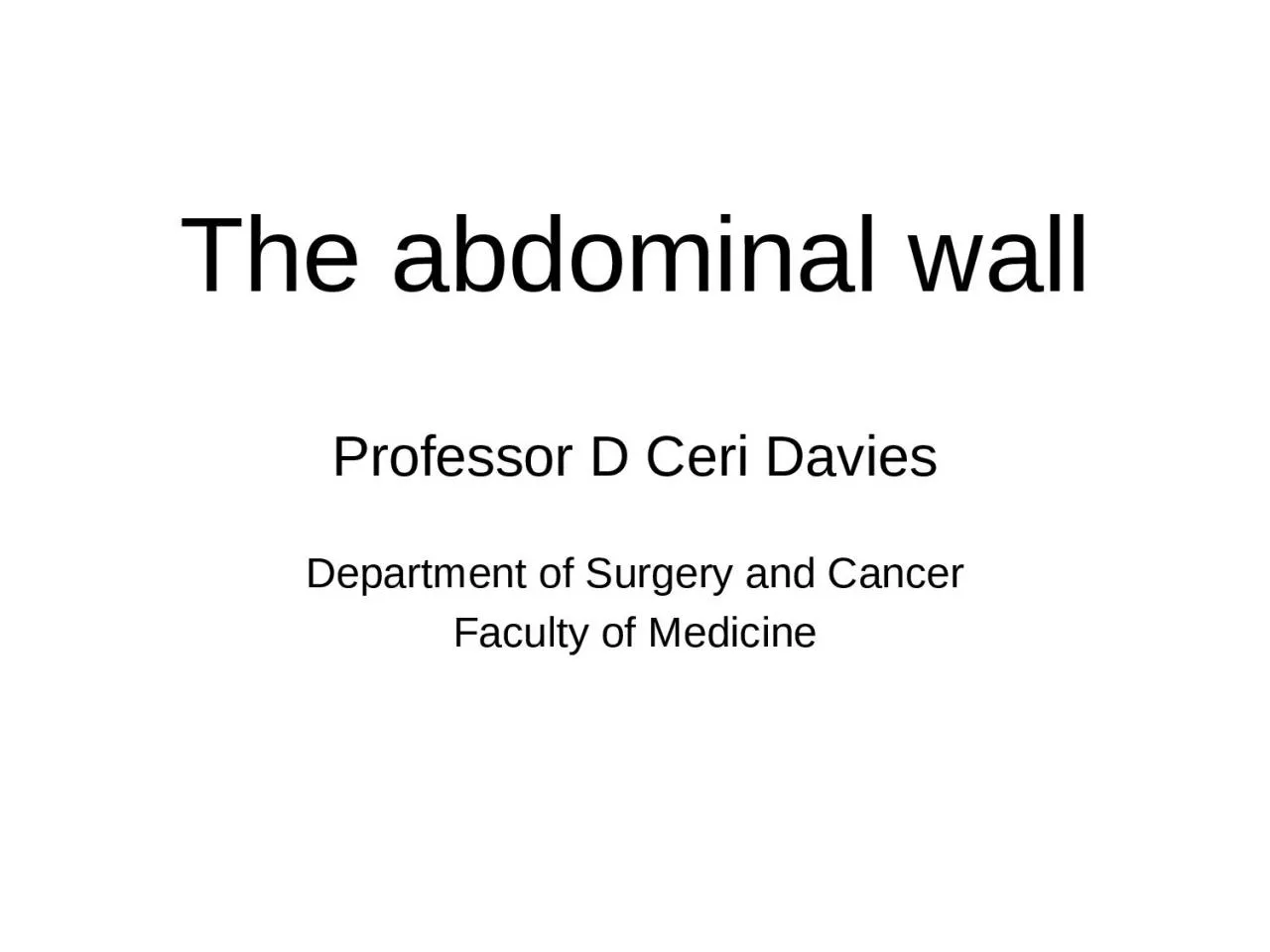

D Ceri Davies Department of Surgery and Cancer Faculty of Medicine Abdominal cavity Regions of the abdomen Three Flank Sheet Muscles External Oblique Internal Oblique Transversus abdominis ID: 1047747
Download Presentation The PPT/PDF document "The abdominal wall Professor" is the property of its rightful owner. Permission is granted to download and print the materials on this web site for personal, non-commercial use only, and to display it on your personal computer provided you do not modify the materials and that you retain all copyright notices contained in the materials. By downloading content from our website, you accept the terms of this agreement.
1. The abdominal wallProfessor D Ceri DaviesDepartment of Surgery and CancerFaculty of Medicine
2.
3. Abdominal cavity
4. Regions of the abdomen
5.
6. Three ‘Flank’ Sheet MusclesExternal ObliqueInternal ObliqueTransversus abdominis Muscles replaced anteriorly by aponeuroses Raise intra-abdominal pressure in expulsion and breathing out Also assist flexion of trunk and “guard” viscera
7. Attachments:Lower 8 ribsFree posterior borderFuses medially with rectus sheathLower border forms inguinal ligamentSuperficial inguinal ringExternal oblique
8. External oblique and its aponeurosisNote the free, thickened inferior edge – the inguinal ligament
9. Lateral Attachments:Continuous line from thoracolumbar fascia, iliac crest and lateral 2/3 of inguinal ligamentMedial AttachmentsCostal marginAponeurosis around rectusConjoint tendonInternal oblique
10.
11. Lateral attachmentsContinuous line from lower 6 costal cartilages (diaphragm)Thoracolumbar fasciaIliac crestLateral 1/3 of inguinal ligamentMedial attachmentsPosterior rectus sheathInternal oblique aponeurosisTransversus abdominis
12.
13. Superior attachments5/6/7 costal cartilagesXiphoid processInferior attachmentsPubic crestPubic symphisisRectus abdominis
14. Rectus Abdominis and the rectus sheathRectus abdominis consists of a series of muscles joined by flatter tendinous intersections – the “six-pack”Everyone has a six-pack, but some protect it in fat
15. Aponeurosis of external, internal obliques and transverus abdominisLinea albaArcuate lineRectus sheath
16. External oblique aponeurosis passes anterior to Rectus abdominisInternal oblique aponeurosis splits round Rectus abdominis
17. The Rectus Sheath – Contribution of Internal Oblique
18. Lateral attachmentsContinuous line from lower 6 costal cartilages (diaphragm)Thoracolumbar fasciaIliac crestLateral 1/3 of inguinal ligamentMedial attachmentsPosterior rectus sheathInternal oblique aponeurosisTransversus abdominis
19.
20. Note the Arcuate Line – below this all the aponeuroses pass anterior to Rectus abdominis so the back of the rectus sheath consists of the transversalis fascia only
21. Two Large Muscles in the Posterior Abdominal WallPsoas major – flexor of the hip or of the trunkQuadratus lumborum – stabiliser of 12th rib, flexor and lateral flexor of the trunk
22. Psoas majorQuadratus lumborumExternal obliqueInternal obliqueTransversus abdominisRectus abdominis
23. Quadratus lumborum
24. Quadratus lumborumPsoas major (narrow muscle lying anterior to it is psoas minor)
25.
26.
27. Intercostal, subcostal and lumbar arteriesSuperior epigastric arteryInferior epigastric arteryBlood supply to abdominal wall
28. Arteries of the Abdominal WallSegmental arteries: Intercostals 7-11, subcostal artery, lumbar arteriesLongitudinal arteries:Superior epigastric (from internal thoracic)Inferior epigastric (from external iliac) These two anastomose to form an anterior by-pass to the aorta.
29.
30. Relationships of the Inferior Epigastric Arteries
31.
32. T7- epigastriumT10- umbilicusL1- inguinal ligamentNerve supply to abdominal wall
33. The entire motor and sensory supply of the abdominal wall derives from T7 – L1
34.
35. AxillaeGroinsLymphatic drainage of abdominal wall
36. The Inguinal Canal
37. Ant wall – Ext Oblique aponeurosis reinforced laterally by int obliqueFloor – Gutter-like upper surface of inguinal lig and its medial pectineal partRoof – Arching fibres of Int oblique ( lat to med) becoming the Conjoint tendon mediallyPost Wall – Transversalis fascia reinforced medially by Conjoint tendonInguinal Canal
38. What makes up a hernia ?DEFECTSACCONTENTS(EG BOWEL)PERITONEUM
39.